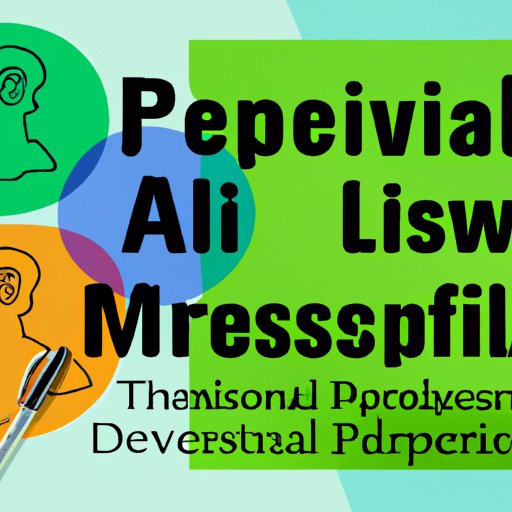Introduction
Multiple personalities, also known as dissociative identity disorder (DID), is a mental health condition that results in the presence of two or more distinct identities or personalities within an individual. These identities have their own unique way of speaking, behaving, and relating to the world around them. While the concept of multiple personalities has been widely studied, it remains a mystery to many. This article will explore the science of multiple personality development and the factors that contribute to its formation. It will also provide insight into the experiences of individuals living with multiple personalities.
The Science of Multiple Personalities: Understanding the Development Process
The study of multiple personalities dates back to the 19th century when it was first identified as a mental disorder. It was initially referred to as multiple personality disorder, but in recent years, it has been renamed dissociative identity disorder. Research shows that the prevalence of DID is relatively rare, affecting only an estimated 1-2% of the population.
The development of multiple personalities is still not well understood, and there is no universally accepted theory that explains how it occurs. However, current theories suggest that the development of multiple personalities may be the brain’s way of coping with severe stress or trauma.
The brain plays a central role in the development of multiple personalities. The condition is believed to result from the fragmentation of one’s sense of self, which can cause dissociation and the compartmentalization of memories, behaviors, and emotions into separate identities. This fragmentation creates distinct, sometimes radically different states of consciousness, which are each associated with their own memories, experiences, and behaviors.
Breaking Down the Causes: Factors that Contribute to Multiple Personality Development
Multiple personality development is believed to result from a combination of multiple factors, including trauma, genetics, and environmental factors.
Trauma is considered the most common cause of DID, especially in individuals who have experienced early childhood abuse or neglect. Ongoing physical, sexual, or emotional abuse can lead to dissociation, which can create new personalities as a way of coping with the trauma.
Genetics also plays a role in the development of multiple personalities. Studies have shown that individuals with close family members that have schizophrenia or bipolar disorder may be more likely to develop DID. However, the link between genetic factors and multiple personality disorder is not yet fully understood.
Environmental factors, such as stress and exposure to traumatic events, can also contribute to the development of multiple personalities.
Exploring Childhood Trauma and Its Link to Multiple Personalities
Childhood trauma is a significant contributing factor to the development of multiple personalities. Severe abuse or neglect at a young age can cause dissociation and create separate identities.
There are several types of childhood trauma that can lead to the development of multiple personalities. Physical, sexual, and emotional abuse, as well as neglect, can all significantly impact a child’s psychological development. The abuse can lead to dissociation, a process where traumatic memories are separated from the individual’s conscious experience, allowing multiple identities to form.
Personal accounts of individuals who have developed multiple personalities due to childhood trauma indicate that the experience is overwhelming and terrifying. Their stories are heartbreaking and show the long-lasting effects of trauma on an individual’s mental health.
Nature vs Nurture: A Look at Genetics and Environmental Factors in Multiplicity
The relationship between genetics and environmental factors is not yet fully understood. Still, studies have shown that genetics can interact with environmental factors, leading to the development of multiple personalities.
Genetic factors play a role in mental health, including the development of multiple personalities. Studies have found that individuals with first-degree relatives that have schizophrenia or bipolar disorder may be at higher risk of developing DID.
The environment can also interact with genetic factors to create a perfect storm that increases the risk of developing multiple personalities. Childhood trauma, physical, emotional, or sexual abuse, can alter a child’s brain development, making them more vulnerable to psychological disorders such as DID.
Living with Multiple Personalities: Personal Accounts and Insight into Development
Living with multiple personalities can be incredibly challenging. Individuals may struggle to maintain coherence and consistency in their thoughts, feelings, and actions.
Personal accounts of individuals living with DID provide insight into the challenges they face, such as stigma, discrimination, and feelings of isolation. Treatment for DID is also challenging, as it requires a long-term commitment to therapy and a willingness to explore painful past experiences.
Despite the challenges, individuals who have received appropriate treatment for DID have reported significant improvement in their ability to function in their daily lives.
Conclusion
Multiple personalities, also known as dissociative identity disorder, is a complex mental health condition that is still not fully understood. The development of multiple personalities is believed to result from a combination of factors, including trauma, genetics, and environmental factors. Childhood trauma is a significant contributing factor to the development of multiple personalities, often causing dissociation and creating separate identities. Despite the challenges of living with DID, with proper treatment, individuals can find relief and make significant progress in controlling their symptoms and reclaiming their lives.
(Note: Is this article not meeting your expectations? Do you have knowledge or insights to share? Unlock new opportunities and expand your reach by joining our authors team. Click Registration to join us and share your expertise with our readers.)
